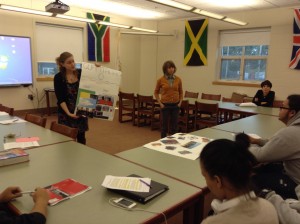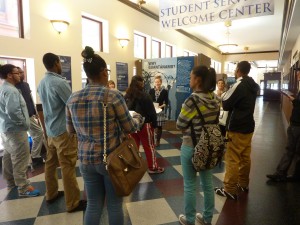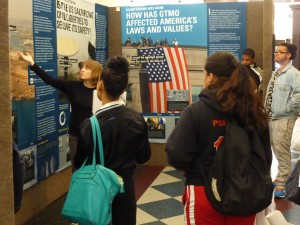A Reflection on Community Engagement in Providence, RI
National Dialogue and Traveling Exhibit
When the teacher asked who had heard of Trujillo, half of the students raised their hands. “When you think of the violence that Haitians refugees fled in the ’90s,” she said, “think of Trujillo.” The students nodded knowingly.
In the months leading up to the exhibit opening, we — the student organizers of the Guantánamo Public Memory Project’s visit to Providence — worked to make the exhibit broadly accessible. To extend our reach to Providence youth, we happily partnered with Juanita Sanchez Educational Complex’s international relations class, “How The World Works.” With the help of a supportive teacher and librarian, we prepared for this group of high school juniors to participate in a preliminary classroom lesson, exhibit visit, and facilitated dialogue.
As we planned, we wondered: would the students connect to the material?
The students, as it turned out, had intimate experience with many of the issues touched on in the Guantánamo Public Memory Project. Reflecting the demographic makeup of much of Providence, the students were either children of immigrants, or immigrants themselves—most coming from the Dominican Republic. Some of them had heard whispers about violent dictators at home. Others had family or friends who struggled with the United State’s immigration system.
After learning about the long, broad history of the U.S. Naval base at Guantánamo Bay through oral histories, slideshow presentations, activities, and the exhibit visit, we honed in on the topic of refugees. We asked the students what they would do if they were policy makers: would they support an open-door policy for refugees? Would health be a factor? How about criminal record? Should economic or political refugees be given precedent? Answers were mixed, reflecting the complexity of the questions. But it was the last question — the treatment of economic and political refugees — that sparked deeply personal responses, with students arguing passionately on both sides.
As it turned out, the personal nature of this material was both an advantage and a challenge. On one hand, students were able to bring their own experiences to the classroom, forging a direct connection to history. On the other hand, the topic certainly hit a nerve. For at least one student, learning about refugees at Guantánamo led to a sense of helplessness; if the U.S. government restricted immigration in the past and continues to restrict immigration in the present, is change even possible?
In a way, the very nature of the Guantánamo Public Memory Project demands this tension; by presenting a multiplicity of narratives, committing to local connections, and asking individual viewers to answer provocative questions, the Project seeks to make Guantánamo personal to anyone who interacts with its content. Our classroom’s reaction begs the question: what do we do with this personal resonance? How do we harness and deploy the energy generated by the Project? Our teaching experience affirmed that dialogue is just the beginning.
By Molly Kerker, Brown University

Raina Fox and Molly Kerker lead discussion at Juanita Sanchez Educational Complex, photo by Peter Quesnel

Raina Fox welcomes students from the Juanita Sanchez Educational Complex to the GPMP exhibit, photo by Rachel Shipps

Molly Kerker talks about Cuban refugees detained at GTMO during Juanita Sanchez tour of the GPMP exhibit, photo by Rachel Shipps
